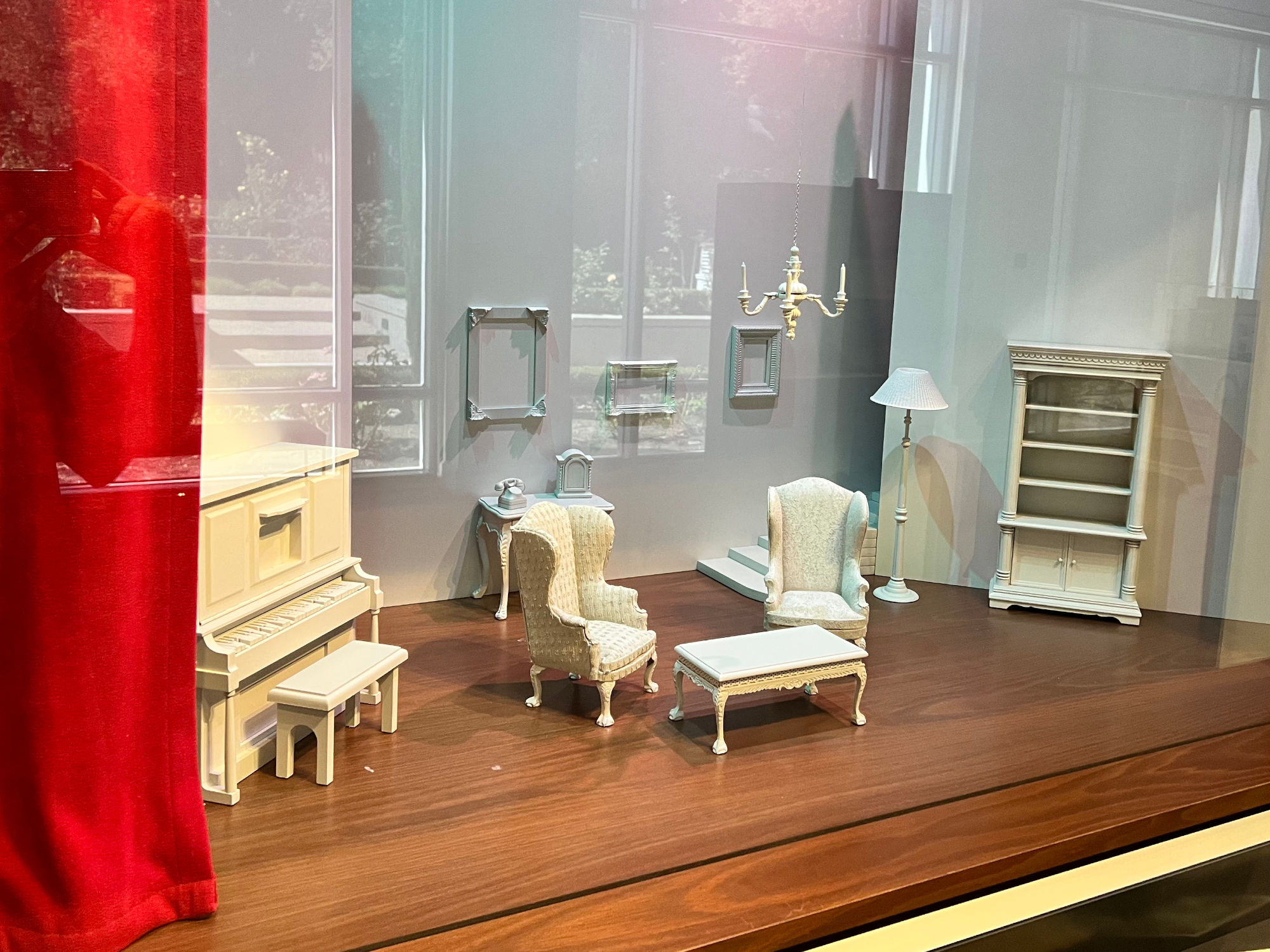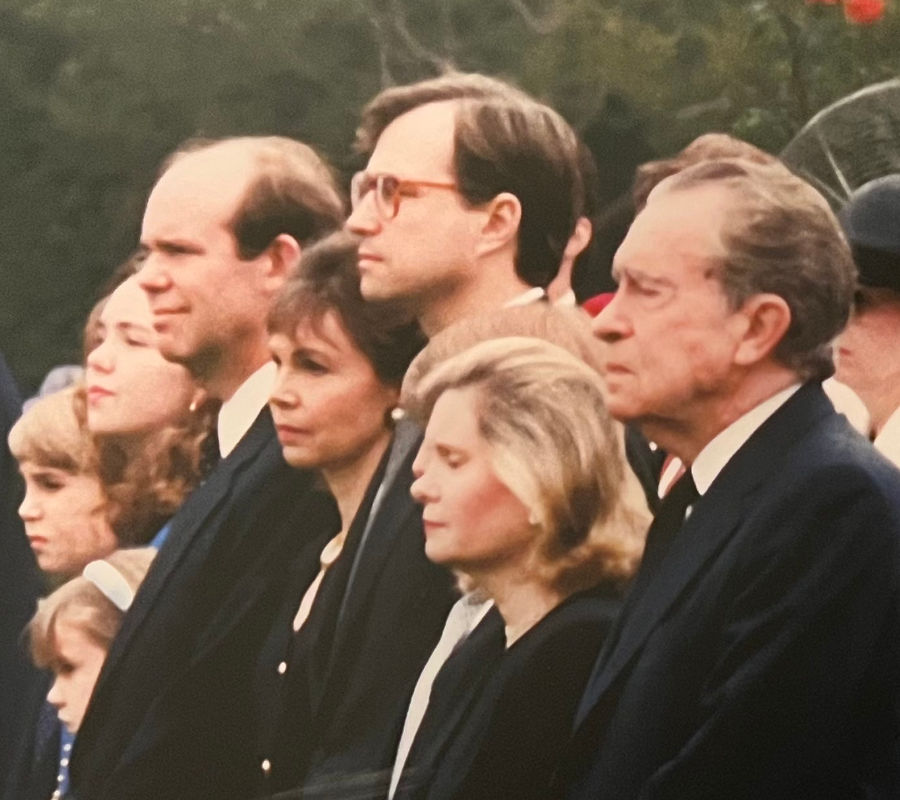From their first meeting at the auditions for The Dark Tower at the Whittier Community Theatre, Nixon knew he'd found the one.
Cast as Barry Jones opposite Pat's Daphne Martin, Dick was persistent in his wooing of the popular Pat - even driving her to Los Angeles for dates with other men because he didn't want her to have to take the long ride on the trolley by herself.
His ardent pursuit was eventually rewarded when Pat agreed to his marriage proposal after more than two years of courtship.


Born on March 16, 1912, the future First Lady's mother named her "Thelma" but her Irish immigrant father called her "Pat" in honor of the next day, St. Patrick's Day. She registered at the University of Southern California as Pat, and sometimes used Patricia.
The trials of Pat's early years growing up poor in Southern California gave her both the determination and the outward calm that would serve her well in public life as the unwavering supporter of her husband and family.
Pat was determined to pull herself up, working constantly and pursuing her education. In 1937 she graduated cum laude from the University of Southern California.
When she met Richard Nixon the next year at The Dark Tower audition, Pat was an intelligent, beautiful, and accomplished woman of 25, living in Whittier and teaching high school business education.

- June 1946 Richard and Pat Nixon with friends on vacation in Seattle, WA
- April 1942 Richard Nixon standing beside a garden pagoda
- February 1938 Playbill for the Whittier Community Players' production of The Dark Tower (Facsimile)
- Play text of The Dark Tower by George S. Kaufman and Alexander Woolcott (Facsimile)
I admired Dick from the very beginning ... but I was having a very good time and wasn't anxious to settle down. I had all these visions of doing all sorts of things, including travel. I always wanted to travel.

- 1935 Lobby Card from the film Becky Sharp (Facsimile)
- 1935 Pay Ryan's stage pass for her work as an extra in Becky Sharp (Facsimile)
- 1935 Newspaper clipping of casting call for Becky Sharp (Facsimile)
For me it was a case of love at first sight ... On the drive home I asked Pat if she would like a date with me. She said: I'm very busy. I said: You shouldn't say that, because someday I am going to marry you!- Richard Nixon Memoirs

- 1932 Thelma Ryan working at the Seton Hospital's pharmacy in New York, NY
- 1937 Richard and his brother Don Nixon (upper right) with the East Whittier Friends Church Choir
- 1937 Pat Ryan's diploma from the University of Southern California (Facsimile)

- 1929 A page from Excelsior High School's yearbook (Facsimile)
- 1920 Thelma Ryan sitting on a chair in her front yard
- 1913 Thelma Ryan being held by her mother, Katherine, with brothers William and Thomas
- 1928 Thelma Ryan and her brother
I may not say much when I am with you - but all of me loves you all of the time.

A formal portait of Pat Nixon, taken in 1943 in San Francisco at the request of Richard who was stationed in the South Pacific during World War II.
It's two o'clock but I just had to write you to say how very much I love you.

Posing in front of the fireplace in the Presidential lounge of the Mission Inn, in Riverside, CA, where they were married
I'd rather be by myself as a steady diet than with most any of the people I know ... Only where you are concerned do I feel otherwise - Dear One.

Pat and Dick were parted for nearly three years by the war. While he was stationed in the South Pacific, she worked for the Office of Price Administration in San Francisco.
They wrote to each other every day, loving letters that bridged the distance between them. They numbered each letter, because mail deliveries were unpredictable. Pat saved all of Dick's letters throughout her life.
First Lady Pat Nixon championed a wide variety of domestic causes, from the environment to education to public health. But perhaps the program she was most known for was volunteerism.
Early in 1969, the White House announced that the First Lady would be embarking on a "national recruitment program" to encourage thousands of citizens to become engaged in volunteerism. The "Vest Pockets of Volunteerism" tour that year took her to 10 different volunteer programs along the West Coast. In 1970 she followed up with another tour, this time visiting programs on college campuses - facing down protesters as she encouraged students to turn their energy to helping others.

The First Lady wears a traditional lappa cloth dress and turban while attending a performance at the National Cultural Center in Monrovia, Liberia.
It seemed to me we were all so busy and so interested that nobody had time to get into trouble. That may be why I believe so wholeheartedly in volunteer work. - June 1969

The First Lady rides on a Conestoga wagon during her trip Medford, Oregon, to transfer the 421 acres of former Camp White Army training base to President Nixon's Legacy of Parks program.
Pat Nixon played an important role as an ambassador of goodwill for the United States all around the world.
She began her travels as Second Lady when her husband was Vice President. She was the most traveled First Lady of her time, and remained so until the 1990s. She visited wounded soldiers in Vietnam and brought supplies to the injured and homeless in earthquake-stricken Peru.
Most of all, Pat Nixon wanted to engage directly with people. A large percentage of her time was taken up with her correspondence: every letter she received was answered with a personal touch. She even made sure to wear dresses designed with pockets to hold the notes people would often hand her.
"She wanted to listen. I felt like this is a woman who really cares about what we are doing. I didn't expect her to be like that." - A college student after meeting the first lady in 1970


First Lady Pat Nixon's shoes (size 9 narrow) and purse.

- Grand Cross of the Order of the Sun - awarded to Pat Nixon for her efforts supporting the victims of the 1970 Peru earthquake
- Gold medallion commemorating the National Parks Centennial - given to Pat Nixon following her Legacy of the Parks tour.


The President and First Lady share a quiet moment in the West Sitting Hall in the second floor White House Residence.


- Red Cross Uniform
First Lady Pat Nixon wore this white uniform while volunteering for the Red Cross. She began her volunteer days with the Red Cross in the early 1940s as a secretary, and continued to volunteer her time to the agency's causes throughout her life. - Red Cross Medal of Merit and Certificate
This commemorative Red Cross medal and certificate was presented to First Lady Pat Nixon by Queen Sirikit of Thailand, for her service to the organization.

As First Lady, Pat Nixon consistently broke the mold in her pursuit of service, outreach, and inspiration.
Mrs. Nixon was the first First Lady to:
- Throw out a baseball for a major league team, at the second game of the 1971 World Series in Baltimore.
- Visit an active combat zone, when she accompanied President Nixon to Vietnam in 1969.
- Receive The Grand Cross of the Order of the Sun (Peru's highest honor) for her efforts in support of the Peruvian people after the 1970 earthquake.
- Address a Republican National Convention, when she spoke in support of her husband in 1972.
- Visit Africa, on a solo 1972 trip where she became the first First Lady to serve as the Personal Representative of the President - a diplomatic status that empowered her to confer with the leaders of Ghana, Liberia, and the Ivory Coast and to represent her husband at the presidential inauguration in Liberia.
"Out of her desire to serve ... she emerged as a force in her own right." - From the 1972 film A Tribute to the First Lady

First Lady Pat Nixon receives the Grand Cross of the Order of the Sun from the Ambassador of Peru, Fernando Berckemeyer, in honor of her aid mission following 1970's devastating earthquake.
Pat Nixon was also notable for the active stands she took on issues regarding women's rights.
The First Lady lobbied her husband to be the first President to put a woman on the Supreme Court, and she didn't accept the American Bar Association's rejection of Nixon's candidate as a reason to abandon the attempt.
She endorsed the Equal Rights Amendment - the first incumbent First Lady to do so.
Pat Nixon even became the first First Lady to make public appearances wearing pants, a strong symbolic action, even as she continued to fit the more traditional role of supportive wife.
I am for equal rights and equal pay. But I don't believe in parades or things like that. I believe the way for women to achieve is to be qualified. - January 1972

The Task Force of Women's Rights and Responsibilities and the Citizens' Advisory on the Status of Women presented this bronze bust to Pat Nixon in 1973. It was a symbolic gesture for the achievements the Nixon Administration made in appointing women to higher and mid-levels of government service.
The Susan B. Anthony bust, designed after Adelaide Johnson's original bust, remained displayed for over 10 years at the East Wing entrance of the White House.
Pat Nixon strove to recapture a sense of the Executive Mansion's grand history by bringing American furniture and decorative arts to the White House collection, an effort that had been launched by First Lady Jacqueline Kennedy in 1961,
In a little more than three years, working closely with Curator Clement Conger, Pat Nixon refurbished and redecorated seven major rooms. She found and, with the generous help of the White House Historical Association and its donors, acquired more than 600 paintings and furnishings for the White House - more than any other First Lady before or since.
Many of these treasures and historical artifacts had been sold or lost over the years. Pat Nixon enjoyed the challenge of finding them and bringing them back, after so many years, to their original home in the White House.
 Perhaps Mrs. Nixon's most brilliant improvement came on November 25, 1970.
With the press of a button (and the months of work preceding it), Mrs. Nixon lit up the exterior of the White House for the first time in history.
Thanks to Pat Nixon the White House is still lit every night.
Perhaps Mrs. Nixon's most brilliant improvement came on November 25, 1970.
With the press of a button (and the months of work preceding it), Mrs. Nixon lit up the exterior of the White House for the first time in history.
Thanks to Pat Nixon the White House is still lit every night.

- The Nixon family has dinner together in their small upstairs dining room. The 19th century painted wallpaper shows scenes from the Revolutionary War.
- The White House Green Room
- December 1971 - Pat Nixon introduces the newly redecorated Green Room.

Patricia Ryan Nixon as painted by Henriette Wyeth Hurd, 1981.
Mrs. Hurd visited the Nixons' home La Casa Pacifica in San Clemente, California where Mrs. Nixon posed for her official White House portrait.
- The portrait currently hangs in the Vermeil Room at the White House.
- Reproduced from a photograph, courtesy of the White House Historical Association.










